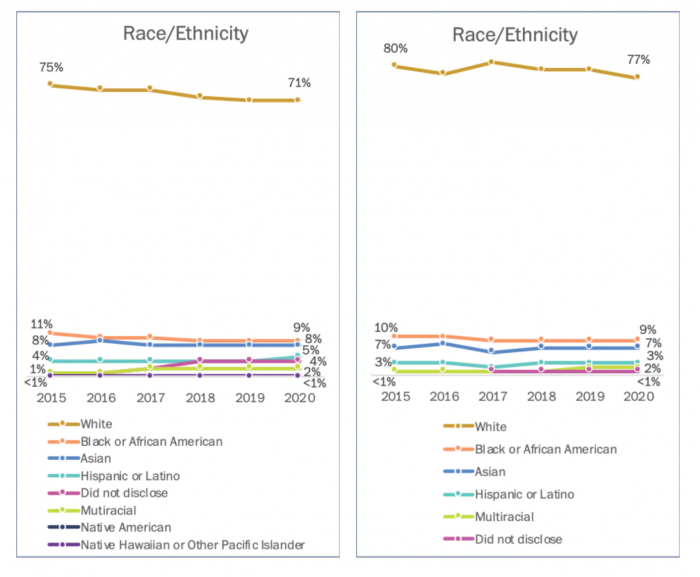The Washington Post for the first time publicly released demographic information for its newsroom and business operations.
Across all of the news organization’s employees, the percent of white employees is 57 percent — the same as 2015. The share of Black employees, however, dropped from 27 to 20 percent over the same time period. Here are the figures for the organization as a whole:

That decrease appears to come primarily from the business side, where the share of Black employees went from 36 to 27 percent overall and from 25 to 22 percent within leadership. Among news and editorial, the percent of Black journalists dropped, but less dramatically (11 to 9 percent). The District of Columbia — home to the Post — is 46 percent Black and 46 percent white, according to the U.S. Census Bureau.
Roughly 11 percent of Washington, D.C. residents identify as Hispanic or Latino. Just 5 percent of the Post’s newsroom and 3 percent of its newsroom leadership said the same. The share of white journalists decreased from 75 to 71 percent newsroom-wide. (Over the same time period, the proportion of those who chose not to disclose their race/ethnicity increased to 4 percent.) Here are the newsroom figures:

As the Washington Post Guild put it, the numbers indicate “there is still much work to be done.” The union published its own report in 2019 that found women, as a group, were paid less than men and that pay disparities between white men and people of color were particularly pronounced. The report, which the newspaper itself called “seriously flawed” because of the limited employment information it made available for analysis, found that median salary was $117,452 for white men and $86,511 for women of color.
The Post’s demographic report, which will now be released annually, comes as major newsrooms are fielding calls to diversify their newsrooms and improve racial representation in their coverage. At The Los Angeles Times, staff centered the newsroom’s demographic information — and, in particular, the relative lack of Black and Hispanic journalists — in their high-profile pushback over racial representation and hiring practices at the paper.Even after the report’s release, some questions remain for The Washington Post. The newspaper, which was purchased by Jeff Bezos in 2013, included demographic information for just the past five years. (Did it not collect information on its staff racial, ethnic, and gender makeup before 2015?) Despite some public requests, the paper did not release the underlining demographic data or share how the report defines a leadership role. Nieman Lab asked for clarification, too, and we’ll update this post with any comment. In the meantime, you can read the full report here.
Today, our company released a demographic report on The Post’s workforce.
The numbers show there is still much work to be done. https://t.co/sJL8p24MsN
— Washington Post Guild (@PostGuild) July 30, 2020
kudos to the Post for doing a report but the first one of these shouldn’t have been released in 2020 https://t.co/nI0D1GHxDK
— Steven Rich (@dataeditor) July 30, 2020
The Washington Post has aggressively expanded since 2015. Yet the share of white newsroom employees has barely budged, from 75 to 71%.
The decline seems almost entirely explained by an increase in non-disclosures. The share of black employees fell. https://t.co/cRv9TvRqIa pic.twitter.com/pBtiPAvn4T
— Kate Rabinowitz (@dataKateR) July 30, 2020
not sure how a major US newsroom, in 2020, is only 4.7 percent Hispanic/Latino.
but here we are!https://t.co/uzaIUhe3Cm pic.twitter.com/HabWQ64iLg
— ric sanchez (@ricsanchez) July 30, 2020